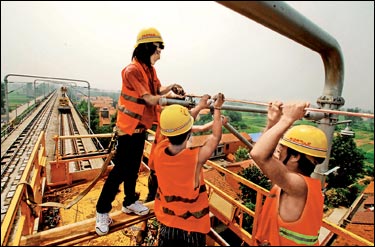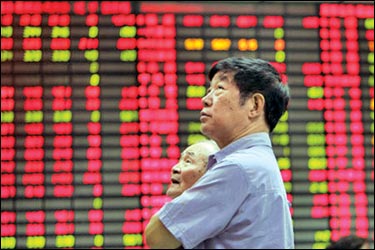Recovery of Asian economies takes shape, uncertainties remain
Zhou Erjie
One year after the financial crisis began to hit the United States
and ravage the world economy, Asia’s emerging economies start to rebound
faster than expected, and show signs of leading the way out of the
slump.
Recent indicators showed the region’s recession - hit economies
outpaced the United States and Europe in the rebound several emerging
economies which have reported GDP figures for the second quarter grew by
an average annualized rate of more than 10 percent.
Stimulus packages
The Chinese economy expanded 7.9 percent year on year in the second
quarter, thanks to multi-billion dollar stimulus packages and record
lending. Surging
|

China - an economic powerhouse in the region. Courtesy: Xinhua |
exports and fiscal spending fueled growth of 2.3 percent for South
Korea’s economy in the three months to June, its fastest rate in more
than five years.
Indonesia’s economy grew 4.4 percent in the second quarter of 2009
year-on-year, mainly supported by increasing government and household
spending. Singapore and Hong Kong have also returned to the growth path
despite sluggish global demand.
For other telling signs, industrial production growth has moved away
from recent lows in Indonesia, Malaysia, the Philippines, Thailand and
Vietnam. In Indonesia, consumer confidence rose during the first six
months of the year. Purchasing managers’ indexes in China and Singapore
have been on the rise as well in recent months. According to Barclays
Capital, emerging Asia is the only region in the world where output has
regained its level before the crisis.
Industrialized economies
When Asian economy was worst hit earlier this year, many analysts
said the impact on Asia showed that the export-dependent region heavily
relies on the demand of the West, and there could be no recovery until
the industrialized economies had rebounded. Later, an IMF report
predicted Asia’s recovery would only be tepid because the developed
economies would remain weak.
However, the reality seems to have showed the other way around. Asia
grows faster than expected despite that the developed countries are
still struggling to rebound.
Central banks in Asia have aggressively reduced policy rates as well
as introducing a variety of other measures to increase liquidity in the
banking system and to encourage banks to expand lending. These measures
clearly worked.
Favourable monetary conditions in China have seen bank lending surge
in the first half of 2009. Bank Indonesia reduced its policy rate seven
times since the beginning of 2009 from 9.25 percent to a record low of
6.75 percent. The Philippine central bank also took a gradual approach
to cutting its policy rate reducing it six times since December 2008.
Fiscal position
Asian governments came into the crisis with a strong fiscal position
and relatively low debt which allowed them to react rapidly and
aggressively, said Mark Williams, an economist with consultancy Capital
Economics.
This has certainly helped shore up growth, and continued loose fiscal
policy could play a role in supporting domestic demand in the next few
years, the economist said.
Government stimulus measures are likely to have a short-term impact,
but what to do if they have run their courses?
The crisis is an opportunity to look at longer-term issues to sustain
Asia’s economic rise, said Jong-Wha Lee, Chief Economist of the Asian
Development Bank (ADB).
It’s unlikely that Asia can export its way out of this slump. This
crisis clearly shows that Asia cannot rely only on external demand but
must diversify its sources of growth and revive its domestic industries,
he said, adding that the process of rebalancing growth may take more
than ten years.
Building up the demand of Asian countries, both domestic and
intra-regional, is crucial to help Asia recover more quickly than the
rest of the world, the economist said.
|

Chinese stock market on the rise. Courtesy: Google |
One notable factor in Asia’s recovery, many analysts said, is China’s
increasingly important role in being the catalyst for the development of
other parts of the world. A Chinese recovery could help to drive global
growth by boosting demand for imported raw materials and industrial
components.
China is leading the world economic recovery based on fresh data from
the first half of the year, said Fred Bergsten, director of the
influential think tank Peterson Institute for International Economics.
China’s trade
Although China’s export growth remained negative compared to numbers
from the same period last year, Bergsten said, the fact that China’s
trade surplus came down a bit is very important and helpful, “because
that gave support to other countries to enable them to take advantage of
the Chinese boom in order to get recovery themselves.”
He noted that China’s import ability during a gloomy world economy is
particularly helpful in the rest of Asia.
A South Korean state-run think tank said in a monthly economy-
assessment report that the Chinese economy has helped South Korea to
bottom out from the recessionary phase.
“Led by China, economies of major trading partners of (South) Korea
have improved, alleviating the decline of exports and increasing
industrial production continuously,” the Korea Development Institute
said.
Philippine President Gloria Macapagal-Arroyo said enhanced regional
trade will help Asian countries like the Philippines rebound despite the
global economic downturn, as China’s consumer- led economy is a big
factor in enhancing recovery.
Big market
“We are happy about China’s successful fiscal stimulus because China
is a big market for the rest of us in the region,” the president said.
“In fact, we have a big surplus in our balance of trade with China,”
said the president in a TV interview, adding that “now our exports will
go up again with China as the ready buyer.”
China can serve as a huge market for emerging East Asian exports,
said an ADB report.
Recent trends show that while exports from Indonesia, Malaysia, and
the Philippines, among others, to the United States have continued
falling, those to the Chinese mainland and Hong Kong have started
increasing.
However, there is a limit to what China can do by itself, said ADB
economist Lei Lei Song. During the first six months of 2009, China’s
total exports dropped 21.8 percent. But imports fell faster - at 25.4
percent - as a substantial portion of China’s imports include
intermediate goods for further processing into final exports to other
countries.
“As global demand for its exports fell, China’s imports fell
further,” Song said.
Even though Asian economies began to rebound, analysts remain
cautious about predicting the advent of the end of the economic crisis.
Actually, they are quite divided on whether the economy now faces a
quick rebound in a V-shaped recovery, a more subdued U-shaped recovery,
or a W-shaped one, in which growth would return for a few quarters, only
to become weaker once more.
Asia rebounds
Such uncertainties are stemmed from the question that whether Asia’s
rebounds are only short-term effects of aggressive government spending
or more solid-based recovery, as more convincing indicators such as
employment rate fall short of supporting it.
As Asian economies began to recover, another danger looms. Policy
makers in these countries face a difficult problem: how to maintain the
growth without blowing up bubbles.
Most stocks markets in Asian countries have seen considerable gains
since the beginning of this year. House prices in some major cities of
Asia are also bottoming out from low levels earlier this year.
China’s central bank, the People’s Bank of China, said last month
that it would use market tools during the second half to reduce risks of
asset bubbles led by a surge in bank loans.
Economists, however, said that there is unlikely to be any
significant policy tightening before next year, as boosting growth would
still be the government’s top priority.
The Asian economic recovery “remains very uneven and shallow ...
despite some signs of a V-shaped rebound.” A general tightening of
liquidity conditions, or even the signaling of such a policy, could
easily stall the nascent recovery, said Kelvin Lau, regional economist
of the Standard Chartered Bank (Hong Kong) Limited.
“A sharp rise in consumer price inflation is a distant threat” given
high unemployment, large spare capacity and weak demand, Lau said.
- Xinhua |



